Hansi Zeng
Can Pre-training Indicators Reliably Predict Fine-tuning Outcomes of LLMs?
Apr 16, 2025Abstract:While metrics available during pre-training, such as perplexity, correlate well with model performance at scaling-laws studies, their predictive capacities at a fixed model size remain unclear, hindering effective model selection and development. To address this gap, we formulate the task of selecting pre-training checkpoints to maximize downstream fine-tuning performance as a pairwise classification problem: predicting which of two LLMs, differing in their pre-training, will perform better after supervised fine-tuning (SFT). We construct a dataset using 50 1B parameter LLM variants with systematically varied pre-training configurations, e.g., objectives or data, and evaluate them on diverse downstream tasks after SFT. We first conduct a study and demonstrate that the conventional perplexity is a misleading indicator. As such, we introduce novel unsupervised and supervised proxy metrics derived from pre-training that successfully reduce the relative performance prediction error rate by over 50%. Despite the inherent complexity of this task, we demonstrate the practical utility of our proposed proxies in specific scenarios, paving the way for more efficient design of pre-training schemes optimized for various downstream tasks.
Search-R1: Training LLMs to Reason and Leverage Search Engines with Reinforcement Learning
Mar 12, 2025Abstract:Efficiently acquiring external knowledge and up-to-date information is essential for effective reasoning and text generation in large language models (LLMs). Retrieval augmentation and tool-use training approaches where a search engine is treated as a tool lack complex multi-turn retrieval flexibility or require large-scale supervised data. Prompting advanced LLMs with reasoning capabilities during inference to use search engines is not optimal, since the LLM does not learn how to optimally interact with the search engine. This paper introduces Search-R1, an extension of the DeepSeek-R1 model where the LLM learns -- solely through reinforcement learning (RL) -- to autonomously generate (multiple) search queries during step-by-step reasoning with real-time retrieval. Search-R1 optimizes LLM rollouts with multi-turn search interactions, leveraging retrieved token masking for stable RL training and a simple outcome-based reward function. Experiments on seven question-answering datasets show that Search-R1 improves performance by 26% (Qwen2.5-7B), 21% (Qwen2.5-3B), and 10% (LLaMA3.2-3B) over SOTA baselines. This paper further provides empirical insights into RL optimization methods, LLM choices, and response length dynamics in retrieval-augmented reasoning. The code and model checkpoints are available at https://github.com/PeterGriffinJin/Search-R1.
ATEB: Evaluating and Improving Advanced NLP Tasks for Text Embedding Models
Feb 24, 2025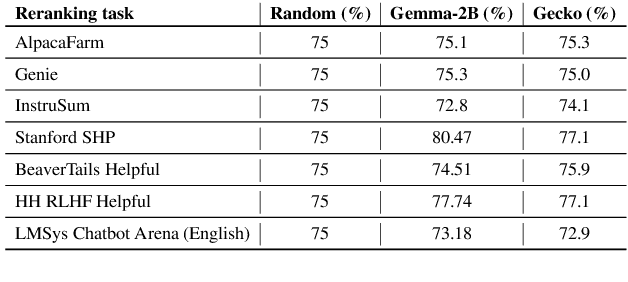
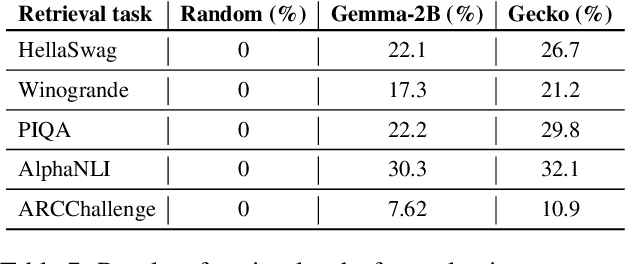
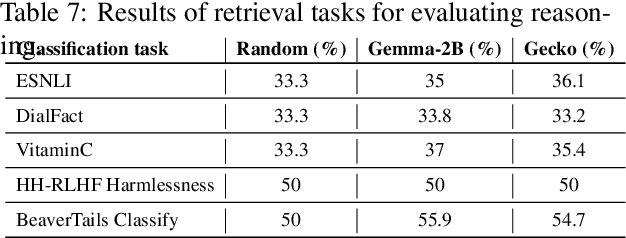

Abstract:Traditional text embedding benchmarks primarily evaluate embedding models' capabilities to capture semantic similarity. However, more advanced NLP tasks require a deeper understanding of text, such as safety and factuality. These tasks demand an ability to comprehend and process complex information, often involving the handling of sensitive content, or the verification of factual statements against reliable sources. We introduce a new benchmark designed to assess and highlight the limitations of embedding models trained on existing information retrieval data mixtures on advanced capabilities, which include factuality, safety, instruction following, reasoning and document-level understanding. This benchmark includes a diverse set of tasks that simulate real-world scenarios where these capabilities are critical and leads to identification of the gaps of the currently advanced embedding models. Furthermore, we propose a novel method that reformulates these various tasks as retrieval tasks. By framing tasks like safety or factuality classification as retrieval problems, we leverage the strengths of retrieval models in capturing semantic relationships while also pushing them to develop a deeper understanding of context and content. Using this approach with single-task fine-tuning, we achieved performance gains of 8\% on factuality classification and 13\% on safety classification. Our code and data will be publicly available.
Scaling Sparse and Dense Retrieval in Decoder-Only LLMs
Feb 21, 2025Abstract:Scaling large language models (LLMs) has shown great potential for improving retrieval model performance; however, previous studies have mainly focused on dense retrieval trained with contrastive loss (CL), neglecting the scaling behavior of other retrieval paradigms and optimization techniques, such as sparse retrieval and knowledge distillation (KD). In this work, we conduct a systematic comparative study on how different retrieval paradigms (sparse vs. dense) and fine-tuning objectives (CL vs. KD vs. their combination) affect retrieval performance across different model scales. Using MSMARCO passages as the training dataset, decoder-only LLMs (Llama-3 series: 1B, 3B, 8B), and a fixed compute budget, we evaluate various training configurations on both in-domain (MSMARCO, TREC DL) and out-of-domain (BEIR) benchmarks. Our key findings reveal that: (1) Scaling behaviors emerge clearly only with CL, where larger models achieve significant performance gains, whereas KD-trained models show minimal improvement, performing similarly across the 1B, 3B, and 8B scales. (2) Sparse retrieval models consistently outperform dense retrieval across both in-domain (MSMARCO, TREC DL) and out-of-domain (BEIR) benchmarks, and they demonstrate greater robustness to imperfect supervised signals. (3) We successfully scale sparse retrieval models with the combination of CL and KD losses at 8B scale, achieving state-of-the-art (SOTA) results in all evaluation sets.
Hypencoder: Hypernetworks for Information Retrieval
Feb 07, 2025



Abstract:The vast majority of retrieval models depend on vector inner products to produce a relevance score between a query and a document. This naturally limits the expressiveness of the relevance score that can be employed. We propose a new paradigm, instead of producing a vector to represent the query we produce a small neural network which acts as a learned relevance function. This small neural network takes in a representation of the document, in this paper we use a single vector, and produces a scalar relevance score. To produce the little neural network we use a hypernetwork, a network that produce the weights of other networks, as our query encoder or as we call it a Hypencoder. Experiments on in-domain search tasks show that Hypencoder is able to significantly outperform strong dense retrieval models and has higher metrics then reranking models and models an order of magnitude larger. Hypencoder is also shown to generalize well to out-of-domain search tasks. To assess the extent of Hypencoder's capabilities, we evaluate on a set of hard retrieval tasks including tip-of-the-tongue retrieval and instruction-following retrieval tasks and find that the performance gap widens substantially compared to standard retrieval tasks. Furthermore, to demonstrate the practicality of our method we implement an approximate search algorithm and show that our model is able to search 8.8M documents in under 60ms.
Inference Scaling for Long-Context Retrieval Augmented Generation
Oct 06, 2024



Abstract:The scaling of inference computation has unlocked the potential of long-context large language models (LLMs) across diverse settings. For knowledge-intensive tasks, the increased compute is often allocated to incorporate more external knowledge. However, without effectively utilizing such knowledge, solely expanding context does not always enhance performance. In this work, we investigate inference scaling for retrieval augmented generation (RAG), exploring strategies beyond simply increasing the quantity of knowledge. We focus on two inference scaling strategies: in-context learning and iterative prompting. These strategies provide additional flexibility to scale test-time computation (e.g., by increasing retrieved documents or generation steps), thereby enhancing LLMs' ability to effectively acquire and utilize contextual information. We address two key questions: (1) How does RAG performance benefit from the scaling of inference computation when optimally configured? (2) Can we predict the optimal test-time compute allocation for a given budget by modeling the relationship between RAG performance and inference parameters? Our observations reveal that increasing inference computation leads to nearly linear gains in RAG performance when optimally allocated, a relationship we describe as the inference scaling laws for RAG. Building on this, we further develop the computation allocation model to estimate RAG performance across different inference configurations. The model predicts optimal inference parameters under various computation constraints, which align closely with the experimental results. By applying these optimal configurations, we demonstrate that scaling inference compute on long-context LLMs achieves up to 58.9% gains on benchmark datasets compared to standard RAG.
Simulating Task-Oriented Dialogues with State Transition Graphs and Large Language Models
Apr 23, 2024Abstract:This paper explores SynTOD, a new synthetic data generation approach for developing end-to-end Task-Oriented Dialogue (TOD) Systems capable of handling complex tasks such as intent classification, slot filling, conversational question-answering, and retrieval-augmented response generation, without relying on crowdsourcing or real-world data. SynTOD utilizes a state transition graph to define the desired behavior of a TOD system and generates diverse, structured conversations through random walks and response simulation using large language models (LLMs). In our experiments, using graph-guided response simulations leads to significant improvements in intent classification, slot filling and response relevance compared to naive single-prompt simulated conversations. We also investigate the end-to-end TOD effectiveness of different base and instruction-tuned LLMs, with and without the constructed synthetic conversations. Finally, we explore how various LLMs can evaluate responses in a TOD system and how well they are correlated with human judgments. Our findings pave the path towards quick development and evaluation of domain-specific TOD systems. We release our datasets, models, and code for research purposes.
Planning Ahead in Generative Retrieval: Guiding Autoregressive Generation through Simultaneous Decoding
Apr 22, 2024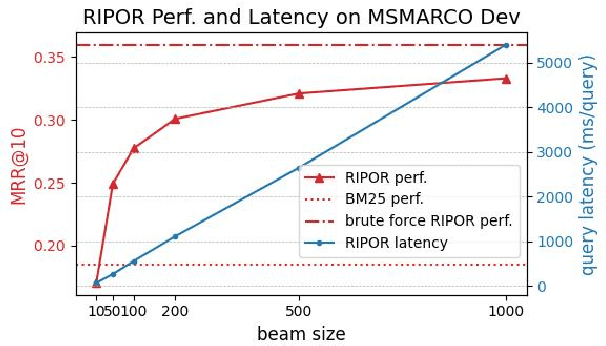
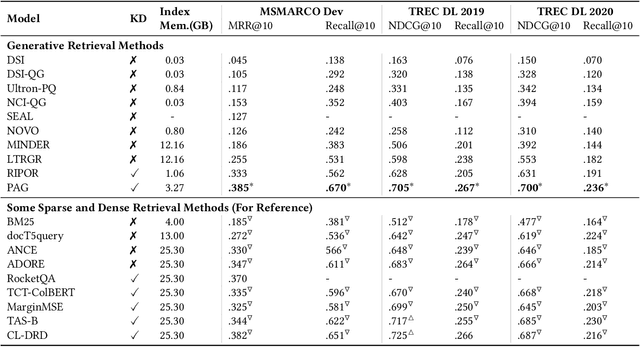

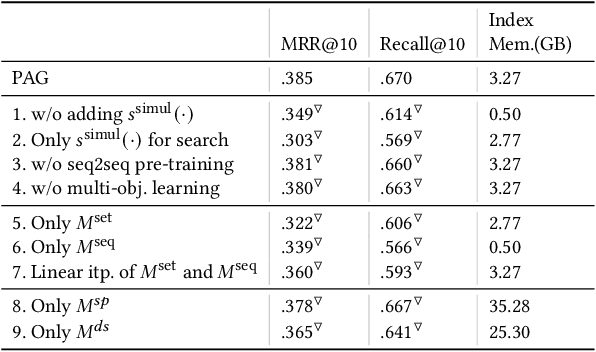
Abstract:This paper introduces PAG-a novel optimization and decoding approach that guides autoregressive generation of document identifiers in generative retrieval models through simultaneous decoding. To this aim, PAG constructs a set-based and sequential identifier for each document. Motivated by the bag-of-words assumption in information retrieval, the set-based identifier is built on lexical tokens. The sequential identifier, on the other hand, is obtained via quantizing relevance-based representations of documents. Extensive experiments on MSMARCO and TREC Deep Learning Track data reveal that PAG outperforms the state-of-the-art generative retrieval model by a large margin (e.g., 15.6% MRR improvements on MS MARCO), while achieving 22x speed up in terms of query latency.
Towards Unified Multi-Modal Personalization: Large Vision-Language Models for Generative Recommendation and Beyond
Mar 27, 2024



Abstract:Developing a universal model that can effectively harness heterogeneous resources and respond to a wide range of personalized needs has been a longstanding community aspiration. Our daily choices, especially in domains like fashion and retail, are substantially shaped by multi-modal data, such as pictures and textual descriptions. These modalities not only offer intuitive guidance but also cater to personalized user preferences. However, the predominant personalization approaches mainly focus on the ID or text-based recommendation problem, failing to comprehend the information spanning various tasks or modalities. In this paper, our goal is to establish a Unified paradigm for Multi-modal Personalization systems (UniMP), which effectively leverages multi-modal data while eliminating the complexities associated with task- and modality-specific customization. We argue that the advancements in foundational generative modeling have provided the flexibility and effectiveness necessary to achieve the objective. In light of this, we develop a generic and extensible personalization generative framework, that can handle a wide range of personalized needs including item recommendation, product search, preference prediction, explanation generation, and further user-guided image generation. Our methodology enhances the capabilities of foundational language models for personalized tasks by seamlessly ingesting interleaved cross-modal user history information, ensuring a more precise and customized experience for users. To train and evaluate the proposed multi-modal personalized tasks, we also introduce a novel and comprehensive benchmark covering a variety of user requirements. Our experiments on the real-world benchmark showcase the model's potential, outperforming competitive methods specialized for each task.
Scalable and Effective Generative Information Retrieval
Nov 15, 2023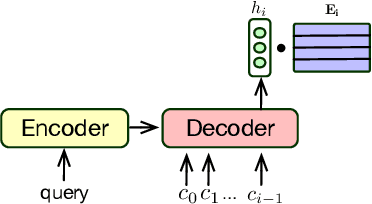
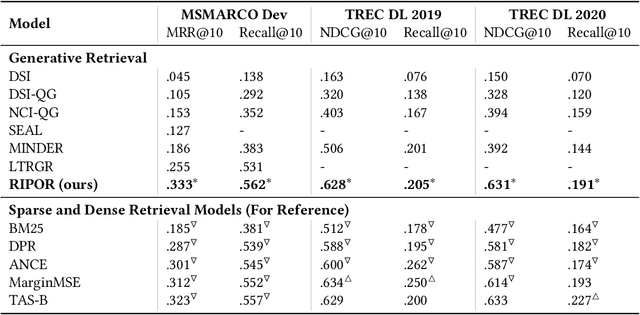
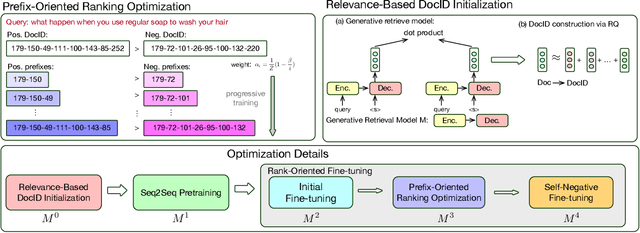
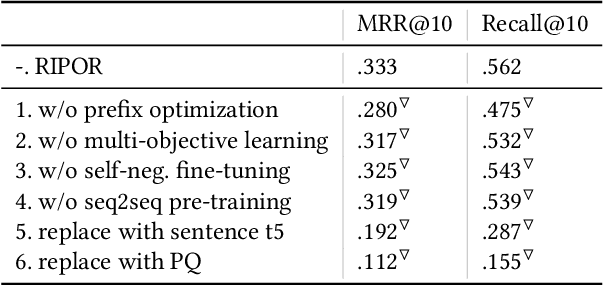
Abstract:Recent research has shown that transformer networks can be used as differentiable search indexes by representing each document as a sequences of document ID tokens. These generative retrieval models cast the retrieval problem to a document ID generation problem for each given query. Despite their elegant design, existing generative retrieval models only perform well on artificially-constructed and small-scale collections. This has led to serious skepticism in the research community on their real-world impact. This paper represents an important milestone in generative retrieval research by showing, for the first time, that generative retrieval models can be trained to perform effectively on large-scale standard retrieval benchmarks. For doing so, we propose RIPOR- an optimization framework for generative retrieval that can be adopted by any encoder-decoder architecture. RIPOR is designed based on two often-overlooked fundamental design considerations in generative retrieval. First, given the sequential decoding nature of document ID generation, assigning accurate relevance scores to documents based on the whole document ID sequence is not sufficient. To address this issue, RIPOR introduces a novel prefix-oriented ranking optimization algorithm. Second, initial document IDs should be constructed based on relevance associations between queries and documents, instead of the syntactic and semantic information in the documents. RIPOR addresses this issue using a relevance-based document ID construction approach that quantizes relevance-based representations learned for documents. Evaluation on MSMARCO and TREC Deep Learning Track reveals that RIPOR surpasses state-of-the-art generative retrieval models by a large margin (e.g., 30.5% MRR improvements on MS MARCO Dev Set), and perform better on par with popular dense retrieval models.
 Add to Chrome
Add to Chrome Add to Firefox
Add to Firefox Add to Edge
Add to Edge